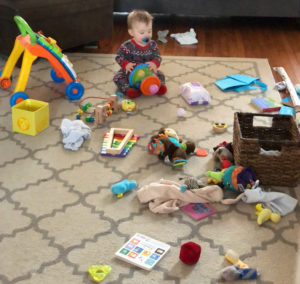Table of Contents
Married couples with kids were once the majority of the population, but that percentage has declined over the years and according to the 2016 Census, just over 42% of all U.S. households include children under 18. Adults are waiting longer to get married and it’s also becoming more common to choose not to have kids at all, both contributing to the decline.

“Wait, what’s this have to do with project management,” you’re wondering. Well, not everyone has kids (yet or at all), but mine have taught me quite a few things over the years. A number of those lessons are surprisingly applicable in my everyday project management work and relationships with clients.
Related Content:
- Content Marketing Agency
- Content Creation Services
- Custom Website Development Services
- Email Marketing Services
I examined my tried and true parenting techniques. What works most of the time? What never works? Of course, with more than one kid something that works really well for one might not suit the other.
Below are my top four parenting lessons-learned that carry over really well to project management.
Preparation is key
I’ve always been a planner. As every type A person will tell you, time is of the essence! And as every parent will tell you, kids take approximately 362 times as long to do any basic task as it really requires. (Seriously, how long does it take to put on socks and shoes?!) I’ve learned to adapt to my schedule not being my own. What changes have I implemented to ensure I’m not running around late and forgetful everywhere I go?
I lay out clothes the night before: mine and both kids (my husband has to fend for himself). I make sure to have the diaper bag well stocked at all times with plenty of the necessities. You better believe there are also little “in-case-of emergencies” extras (like a rarely seen toy or book, bonus pacifier or snack). Every weeknight before I sit down for the evening, I make sure my little one has bottles and finger foods prepped ready for school tomorrow. I put my coffee cup under the Nespresso. Much like SEO efforts, every little bit adds up!
You never know what’s going to impede your efforts to get out of the door. Some mornings everyone wakes up on time, no one is hangry and no one spills an entire glass of milk on three people simultaneously. Those mornings are rare, but preparation helps me avoid any major departure delays.

To carry that practice over at work, I like to prepare for tomorrow’s meetings today. I write agendas in advance, make sure I’ve reviewed recent client news and blog postings, and have visited their website. Each day, I set up alerts on Google and ahrefs. I check in with team members before any meetings to make sure they’re up to speed on what they need to cover.
Research has shown that if you write down tomorrow’s to-do list before you go to bed, you’re likely to fall asleep faster. And the idea behind that makes sense. The more you’ve unloaded off your memory, the less there is for your mind to race through before settling into sleep. And remember, you never know what’s going to derail your efforts any given workday, so again preparation is key.
Scheduling Nightmares
Admittedly, my kids are preschool-aged and younger, so I’m not exactly coordinating school functions, sports practice, and events along with friend hangouts and family time. (But we did just sign up for soccer later this month.) Still, there are plenty of family calendars to coordinate. I can’t believe how many 3-year-old birthday parties my son has been invited to in the last year!
Don’t make a 2 pm appointment for a haircut across town when you’ll be at a birthday party until 1:30. You won’t leave on time (and don’t even try to pull your kid(s) away before the birthday cake) and you’ll be stuck hoping the salon is understanding and can squeeze you in when you show up well past your time slot. (Plus, it comes across a bit rude to not respect the appointment time.) We learned that one the hard way.

When planning out meetings, anticipate that things might take longer than you think they will. You may have a set agenda that should only take half an hour to work through, but that doesn’t allow for any naturally occurring feedback or discussion. Both are crucial to better understanding your client’s concerns, their industry and to building a positive relationship.
You’ll also want to give yourself some wiggle room when planning out project milestones. Key decision makers might encounter unavoidable hurdles that cause understandable (or frustrating) delays. Those delays can snowball and if you’re unable to get back on track, the entire project can suffer. Pad out the schedule, it’s always better to over deliver than fall short of expectations.
Communication Clarity
Clear, concise communication. It’s critical in preventing meltdowns. I’m no stranger to being on the receiving end of a toddler tantrum. However, I’ve learned that I can mitigate a good portion of those by clearly conveying my expectations. Kids don’t like change; they’re creatures of habit and love knowing what to expect. So, when you abruptly interrupt them to change gears, they’re going to push back.
Let’s say we need to leave the house in 15 minutes. Working backwards, that means we need to start heading toward the car in 10 minutes, meaning my son should begin putting his socks and shoes on in 5. (Remember, it can inexplicably take 5 minutes or more for a toddler to do any 30 second task!) If he’s actively playing and in 5 minutes I ask him to stop, he’s not going to be interested. I’ve given him no warning and he’s busy. If I give him a heads up, “Hey kiddo, in 5 minutes, we’re going to start getting ready to go, why don’t you pick one more thing to play with before we leave,” then he’s much more receptive to the change in scenery.

Every good PM knows that clear, concise communication is critical with clients. You must set up realistic expectations, track goals and tailor your approach client-to-client. Speaking of expectations, that includes pre-conceived notions or background knowledge. I expect that our clients have a general understanding of the topic at hand, but still explain the reasoning behind our recommendations. Even examining the language you use is helpful. For example, one of the services we offer here at Go Fish is broadly “content marketing” but more specifically, we execute “creative content campaigns.” The word “content” is fairly loaded, especially to marketers, so it’s very helpful to initially and continually clarify expectations and goals.
Some clients will be really receptive to constant communication in writing with regular calls, too – these clients don’t believe in over-communication. On the other end of the spectrum, some clients would rather not be bothered with the details. They outsourced the work for a reason. I don’t like to guess which method of communication a client prefers – it’s one of the first questions I ask.
At the end of the day, poor communication is going to be a factor in just about every negative client experience. Which is to say, I like to communicate early and often.
Scope
Ah, good old scope creep. We’re all familiar with it. When a client wants to add on one little thing here, and there, and over there too, and suddenly you’re managing an entirely different project. It’s important to remember the overall goal at the end of the day.
A couple of weekends ago we took the family to the Durham Life and Science museum. As my son was ever so carefully navigating the ropes in the treehouse area, I watched the backlog develop. Slowly but surely, a line of impatient little ones was forming behind my trepidatious kiddo. I apologized to one of the waiting dads near me and he said, “if we’re in a hurry today, we’re in the wrong place; today is all about fun.” And I thought that was such a great insight. I was focused on the details — my kid slowing everyone and everything down — but the goal of the day was to get out of the house and play.

Similarly, clients can throw you off your plan at any given turn. It’s important to step back and ask whether or not the requested change is going to affect the overall goal of the project. Once you’ve determined the impact a change of direction or delay might have to the overall project, you can more accurately plan your course of action. You can then adjust any schedules and clearly communicate impact back to the client.
Plan ahead thoughtfully, but be nimble enough to reassess and adjust. It’s easier said than done. But hopefully, some of the above tips will help you with your next project, at home or in the office.
Search News Straight To Your Inbox
*Required
Join thousands of marketers to get the best search news in under 5 minutes. Get resources, tips and more with The Splash newsletter: